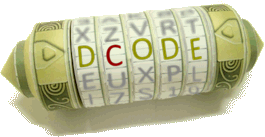Tool to calculate the altitude (elevation) of a point on Earth from its coordinates (GPS point, latitude, longitude)
GPS Elevation - dCode
Tag(s) : Geography
dCode is free and its tools are a valuable help in games, maths, geocaching, puzzles and problems to solve every day!
A suggestion ? a feedback ? a bug ? an idea ? Write to dCode!
GPS Elevation
Altitude from GPS point Calculator
Answers to Questions (FAQ)
What is elevation of a GPS point? (Definition)
The GPS coordinates contain only 2 pieces of information: latitude and longitude on the terrestrial globe. Altitude (or elevation, or z value) is the height of the point on Earth, relative to the sea level which is counted as the base altitude (0 meters).
How to calculate the elevation of a GPS point?
Altitude cannot be calculated from coordinates directly, there is not and never will be a calculation formula.
However, NASA's satellites (and others) scoured the Earth's surface with radars and more or less accurately modeled the elevation of each point on the globe. dCode uses this data to find the altitude of a GPS point (reference geoid). dCode uses this data to find the altitude of a GPS point.
Example: The altitude of the Greenwich Observatory (longitude: 0, latitude: 51.478) is approximately 37 m
NB: The values given take the sea level as an altimetric reference.
The altitudes found are subject to a margin of error of 1 to 2% (approximately ±10m), depending on the sources used, they may vary slightly by a few meters.
How is altitude 0 calculated?
Altitude 0 is usually decided with reference to mean sea level, which serves as a standard starting point for measuring altitudes.
It is also possible to define altitude 0 from a reference geoid describing the Earth (there are several, depending on the country).
Globally, sea level is not constant, exhibiting variations of up to ±2 m from the reference geoid.
How to know the altitude of a house/building?
Knowing the precise altitude of a house or building is more complex. Specialized tools such as laser altimeters or topographical surveys may be needed to get an accurate measurement of the elevation of a specific building. The height of a house is generally relative to its foundation, add the height of the ground to obtain an absolute altitude.
How to download elevation data?
Altitude/terrain data represents gigabytes of digits, there are several research studies that offer it. SRTM (Shuttle Radar Topography Mission) data, among the most comprehensive on the globe, is available here
What is the difference between GPS altitude and barometric altitude?
GPS altitude is based on measurements made by satellites. Barometric altitude, on the other hand, is measured using an atmospheric pressure sensor built into some altimeters, which uses changes in pressure to estimate altitude. The two methods may provide slightly different results.
Source code
dCode retains ownership of the "GPS Elevation" source code. Any algorithm for the "GPS Elevation" algorithm, applet or snippet or script (converter, solver, encryption / decryption, encoding / decoding, ciphering / deciphering, breaker, translator), or any "GPS Elevation" functions (calculate, convert, solve, decrypt / encrypt, decipher / cipher, decode / encode, translate) written in any informatic language (Python, Java, PHP, C#, Javascript, Matlab, etc.) or any database download or API access for "GPS Elevation" or any other element are not public (except explicit open source licence). Same with the download for offline use on PC, mobile, tablet, iPhone or Android app.
Reminder: dCode is an educational and teaching resource, accessible online for free and for everyone.
Cite dCode
The content of the page "GPS Elevation" and its results may be freely copied and reused, including for commercial purposes, provided that dCode.fr is cited as the source (Creative Commons CC-BY free distribution license).
Exporting the results is free and can be done simply by clicking on the export icons ⤓ (.csv or .txt format) or ⧉ (copy and paste).
To cite dCode.fr on another website, use the link:
In a scientific article or book, the recommended bibliographic citation is: GPS Elevation on dCode.fr [online website], retrieved on 2025-07-08,
